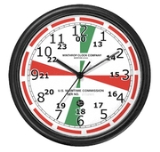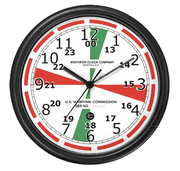
2182 kHz
Encyclopedia
The radio frequency of 2182 kHz (kilohertz) is the international calling and distress frequency
for maritime
radiotelephone
communications on the marine MF
bands.
(SSB) (upper sideband
only), however amplitude modulation
(AM) and some variants such as vestigial sideband are still in use, mainly by vessels with older equipment and by some coastal stations in an attempt to ensure compatibility with older and less sophisticated receivers.
on the marine VHF band
, but unlike VHF which is limited to ranges of about 20 to 50 nmi (37 to 92.6 km) depending on antenna height, communications on 2182 kHz and nearby frequencies have a reliable range of around 50 to 150 nmi (92.6 to 277.8 km) during the day and 150 to 300 nmi (277.8 to 555.6 km) or sometimes more at night. The reception range of even a well-equipped station can be severely limited in summer because of static
caused by lightning.
 All stations using 2182 kHz were required to maintain a strictly enforced three-minute silence and listening period twice each hour, starting at h+00, h+30. This allowed any station with distress, urgent or safety traffic the best chance of being heard at that time, even if they were at some distance from other stations, operating on reduced battery power or perhaps reduced antenna efficiency, as for example from a dismasted vessel. As a visual aide-memoire, a typical clock in a ship's radio room would have these silence periods marked by shading the sectors
All stations using 2182 kHz were required to maintain a strictly enforced three-minute silence and listening period twice each hour, starting at h+00, h+30. This allowed any station with distress, urgent or safety traffic the best chance of being heard at that time, even if they were at some distance from other stations, operating on reduced battery power or perhaps reduced antenna efficiency, as for example from a dismasted vessel. As a visual aide-memoire, a typical clock in a ship's radio room would have these silence periods marked by shading the sectors
from h+00 to h+03 and from h+30 to h+33 in green. Similar sectors were marked in red for what used to be the corresponding silence and listening period on 500 kHz between h+15 and h+18 and from h+45 to h+48. These silence periods are no longer required as the introduction of GMDSS has produced alternative automatic watchkeeping systems and the 500 kHz band is no longer in use for maritime traffic.
(GMDSS). It has an associated DSC
frequency at 2187.5 kHz. Other international distress frequencies, in use as of 2008, include:
The U.S. Coast Guard only monitors distress alert signals broadcast using digital 406 MHz emergency position indicating radio beacons as of 1 Feb. 2009. Satellite processing from all 121.5 or 243 MHz locators was discontinued. Digital 406 MHz models became the only ones approved for use in both commercial and recreational watercraft worldwide on 1 Jan. 2007, the Coast Guard said.
International distress frequency
Since early in the 20th century, the radio frequency of 500 kilohertz has been an international calling and distress frequency for Morse code maritime communication. The unit kilohertz was not introduced until 1960...
for maritime
Ocean
An ocean is a major body of saline water, and a principal component of the hydrosphere. Approximately 71% of the Earth's surface is covered by ocean, a continuous body of water that is customarily divided into several principal oceans and smaller seas.More than half of this area is over 3,000...
radiotelephone
Radiotelephone
A radiotelephone is a communications system for transmission of speech over radio. Radiotelephone systems are not necessarily interconnected with the public "land line" telephone network. "Radiotelephone" is often used to describe the usage of radio spectrum where it is important to distinguish the...
communications on the marine MF
Medium frequency
Medium frequency refers to radio frequencies in the range of 300 kHz to 3 MHz. Part of this band is the medium wave AM broadcast band. The MF band is also known as the hectometer band or hectometer wave as the wavelengths range from ten down to one hectometers...
bands.
Transmission modes
Transmissions on 2182 kHz commonly use single-sideband modulationSingle-sideband modulation
Single-sideband modulation or Single-sideband suppressed-carrier is a refinement of amplitude modulation that more efficiently uses electrical power and bandwidth....
(SSB) (upper sideband
Sideband
In radio communications, a sideband is a band of frequencies higher than or lower than the carrier frequency, containing power as a result of the modulation process. The sidebands consist of all the Fourier components of the modulated signal except the carrier...
only), however amplitude modulation
Amplitude modulation
Amplitude modulation is a technique used in electronic communication, most commonly for transmitting information via a radio carrier wave. AM works by varying the strength of the transmitted signal in relation to the information being sent...
(AM) and some variants such as vestigial sideband are still in use, mainly by vessels with older equipment and by some coastal stations in an attempt to ensure compatibility with older and less sophisticated receivers.
Range
2182 kHz is analogous to channel 16Channel 16 VHF
Channel 16 VHF is a radio frequency on the marine VHF radio band. It is used for shipping and maritime purposes, to call up ships and shore stations, and as an international distress frequency. After an initial response the call is to be switched to one of the working channels, except in case of...
on the marine VHF band
Marine VHF radio
Marine VHF radio is installed on all large ships and most seagoing small craft. It is used for a wide variety of purposes, including summoning rescue services and communicating with harbours, locks, bridges and marinas, and operates in the VHF frequency range, between 156 to 174 MHz...
, but unlike VHF which is limited to ranges of about 20 to 50 nmi (37 to 92.6 km) depending on antenna height, communications on 2182 kHz and nearby frequencies have a reliable range of around 50 to 150 nmi (92.6 to 277.8 km) during the day and 150 to 300 nmi (277.8 to 555.6 km) or sometimes more at night. The reception range of even a well-equipped station can be severely limited in summer because of static
Static
Static has several meanings:* Static electricity, a net charge of an object** The triboelectric effect, e.g. from shoes rubbing carpet* White noise, a random signal with a flat power spectral density** Noise , a type of radio interference...
caused by lightning.
Silence period

Circular sector
A circular sector or circle sector, is the portion of a disk enclosed by two radii and an arc, where the smaller area is known as the minor sector and the larger being the major sector. In the diagram, θ is the central angle in radians, r the radius of the circle, and L is the arc length of the...
from h+00 to h+03 and from h+30 to h+33 in green. Similar sectors were marked in red for what used to be the corresponding silence and listening period on 500 kHz between h+15 and h+18 and from h+45 to h+48. These silence periods are no longer required as the introduction of GMDSS has produced alternative automatic watchkeeping systems and the 500 kHz band is no longer in use for maritime traffic.
Licensing
In order to operate a marine radio transmitter on 2182 kHz, the operator must hold a GMDSS General Operating Certificate for mandatory installations, a Long Range Certificate for voluntary ones, or other equivalent and recognised radio operator's qualifications. Both these certificates have a wider syllabus than those of the GMDSS Restricted Operators Course or the RYA Short Range Certificate that is necessary for marine VHF use. In practice, an unqualified operator would not be prosecuted for the use of either transmitter in what turns out to be a genuine distress situation.Related distress frequencies
2182 kHz forms an essential part of the Global Maritime Distress Safety SystemGlobal Maritime Distress Safety System
The Global Maritime Distress and Safety System is an internationally agreed-upon set of safety procedures, types of equipment, and communication protocols used to increase safety and make it easier to rescue distressed ships, boats and aircraft....
(GMDSS). It has an associated DSC
Digital Selective Calling
Digital Selective Calling or DSC is a standard for sending pre-defined digital messages via the medium frequency , high frequency and very high frequency maritime radio systems. It is a core part of the Global Maritime Distress Safety System .-Workings:DSC was developed to replace a call in older...
frequency at 2187.5 kHz. Other international distress frequencies, in use as of 2008, include:
- 121.5 MHz as the civil, and 243 MHz as the military aircraft emergency frequenciesAircraft emergency frequencyThe aircraft emergency frequency is a frequency used on the aircraft radio band reserved for emergency communications for aircraft in distress. The frequencies are 121.5 MHz for civilian, also known as International Air Distress and 243.0 MHz for military use, also known as Military Air...
- Marine VHF radioMarine VHF radioMarine VHF radio is installed on all large ships and most seagoing small craft. It is used for a wide variety of purposes, including summoning rescue services and communicating with harbours, locks, bridges and marinas, and operates in the VHF frequency range, between 156 to 174 MHz...
channel 16, (156.8 MHz) for short range maritime use - 406.025 MHz used by the Cospas-SarsatCospas-SarsatCospas-Sarsat is an international satellite-based search and rescue distress alert detection and information distribution system, established by Canada, France, the United States, and the former Soviet Union in 1979. It is best known as the system that detects and locates emergency beacons...
international satellite-based search and rescueSearch and rescueSearch and rescue is the search for and provision of aid to people who are in distress or imminent danger.The general field of search and rescue includes many specialty sub-fields, mostly based upon terrain considerations...
(SAR) distress alert detection and information distribution system
The U.S. Coast Guard only monitors distress alert signals broadcast using digital 406 MHz emergency position indicating radio beacons as of 1 Feb. 2009. Satellite processing from all 121.5 or 243 MHz locators was discontinued. Digital 406 MHz models became the only ones approved for use in both commercial and recreational watercraft worldwide on 1 Jan. 2007, the Coast Guard said.
See also
- Distress signalDistress signalA distress signal is an internationally recognized means for obtaining help. Distress signals take the form of or are commonly made by using radio signals, displaying a visually detected item or illumination, or making an audible sound, from a distance....
- Marine VHF radioMarine VHF radioMarine VHF radio is installed on all large ships and most seagoing small craft. It is used for a wide variety of purposes, including summoning rescue services and communicating with harbours, locks, bridges and marinas, and operates in the VHF frequency range, between 156 to 174 MHz...
- Mayday (distress signal)Mayday (distress signal)Mayday is an emergency procedure word used internationally as a distress signal in voice procedure radio communications. It derives from the French venez m'aider, meaning "come help me"....
- Pan-panPan-panIn radiotelephone communications, a call of three repetitions of pan-pan is used to signify that there is an urgency on board a boat, ship, aircraft or other vehicle but that, for the time being at least, there is no immediate danger to anyone's life or to the vessel itself. This is referred to as...
- SecuriteSecuriteWhen a marine radio transmission begins with "Sécurité, sécurité, sécurité" , it means that what follows is important safety information. The most common use of this is by coast radio stations before the broadcast of navigational warnings and meteorological information.It is normal practice to...
- Global Maritime Distress Safety SystemGlobal Maritime Distress Safety SystemThe Global Maritime Distress and Safety System is an internationally agreed-upon set of safety procedures, types of equipment, and communication protocols used to increase safety and make it easier to rescue distressed ships, boats and aircraft....
- 500 kHz

